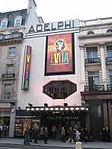Civil Service Supply Association
Co-operatives in EnglandDefunct department stores of the United KingdomDefunct retail companies of the United KingdomRetail companies established in 1865Shops in London ... and 1 more
Use British English from August 2015
Civil Service Supply Association was a department store on the Strand, London. Founded in the 1860s on Victoria Street, the shop moved to the Strand in the following decade, remaining open until 1982.
Excerpt from the Wikipedia article Civil Service Supply Association (License: CC BY-SA 3.0, Authors).Civil Service Supply Association
Agar Street, London Covent Garden
Geographical coordinates (GPS) Address Nearby Places Show on map
Geographical coordinates (GPS)
| Latitude | Longitude |
|---|---|
| N 51.5097 ° | E -0.1237 ° |
Address
Agar Street 6
WC2N 4HN London, Covent Garden
England, United Kingdom
Open on Google Maps









